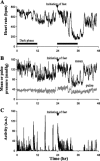Cardiovascular changes during daily torpor in the laboratory mouse
- PMID: 19587115
- PMCID: PMC3774276
- DOI: 10.1152/ajpregu.00131.2009
Cardiovascular changes during daily torpor in the laboratory mouse
Abstract
The laboratory mouse is a facultative daily heterotherm in that it experiences bouts of torpor under caloric restriction. Mice are the most frequently studied laboratory mammal, and often, genetically modified mice are used to investigate many physiological functions related to weight loss and caloric intake. As such, research documenting the cardiovascular changes during fasting-induced torpor in mice is warranted. In the current study, C57BL/6 mice were implanted either with EKG/temperature telemeters or blood pressure telemeters. Upon fasting and exposure to an ambient temperature (T(a)) of 19 degrees C, mice entered torpor bouts as assessed by core body temperature (T(b)). Core T(b) fell from 36.6 +/- 0.2 degrees C to a minimum of 25.9 +/- 0.9 degrees C during the fast, with a concomitant fall in heart rate from 607 +/- 12 beats per minute (bpm) to a minimum of 158 +/- 20 bpm. Below a core T(b) of 31 degrees C, heart rate fell exponentially with T(b), and the Q(10) was 2.61 +/- 0.18. Further, mice implanted with blood pressure telemeters exhibited similar heart rate and activity profiles as those implanted with EKG/temperature telemeters, and the fall in heart rate and core T(b) during entrance into torpor was paralleled by a fall in blood pressure. The minimum systolic, mean, and diastolic blood pressures of torpid mice were 62.3 +/- 10.2, 51.9 +/- 9.2, 41.0 +/- 7.5 mmHg, respectively. Torpid mice had a significantly lower heart rate (25-35%) than when euthermic at mean arterial pressures from 75 to 100 mmHg, suggesting that total peripheral resistance is elevated during torpor. These data provide new and significant insight into the cardiovascular adjustments that occur in torpid mice.
Figures






References
-
- Bouthegourd JC, Martin JC, Gripois D, Roseau S, Tome D, Even PC. Fat-depleted CLA-treated mice enter torpor after a short period of fasting. Appetite 42: 91–98, 2004 - PubMed
-
- Cannon B, Nedergard J. Brown adipose tissue: function and physiological significance. Physiol Rev 84: 277–359, 2004 - PubMed
-
- Cariou B, Bouchaert E, Abdelkarim M, Dumont J, Caron S, Fruchart JC, Burcelin R, Kuipers F, Staels B. FXR-deficiency confers increased susceptibility to torpor. FEBS Lett 581: 5191–5198, 2007 - PubMed
-
- Chatfield PO, Lyman CP. Circulatory changes during process of arousal in the hibernating hamster. Am J Physiol 163: 566–574, 1950 - PubMed
-
- Cranford JA. Body temperature, heart rate and oxygen consumption of normothermic and heterothermic Western jumping mice (Zapus princeps). Comp Biochem Physiol A 74: 595–599, 1983 - PubMed
Publication types
MeSH terms
Grants and funding
LinkOut - more resources
Full Text Sources
Research Materials

